With biophilic design on the rise, sustainable décor is the right choice for both homes and commercial spaces. Green decor is trending in the United States because it is eco-friendly and also emanates a calming vibe. Aligned with this design ethos, vertical gardens or green walls are an excellent choice for modern interiors. Green walls are space-efficient, environment-friendly, and pair well with other design elements and materials. Moreover, they can be customized in terms of color, design, and shape to merge seamlessly with your aesthetic. Hence, they are the perfect way to bring natural elements into your home, office, or business establishment.
Green walls can further be classified into living walls and preserved moss walls. While they are quite similar in certain aspects, each offers its unique set of benefits. With years of experience in green wall installation, we at Eco Brooklyn can help you choose between living and preserved walls as per your needs. Here is an in-depth guide to get you started.
What Are Living Walls?
Living walls are green walls or vertical gardens designed using live plants. Hence, just like regular gardens, living walls require soil, sunlight, and water to prosper. These walls can be constructed using a variety of plants, depending on the look you are going for. However, the advantage of using live moss for living walls is that it doesn’t need soil to grow. It can grow on materials such as rocks or wood, provided it gets moisture and sunlight.
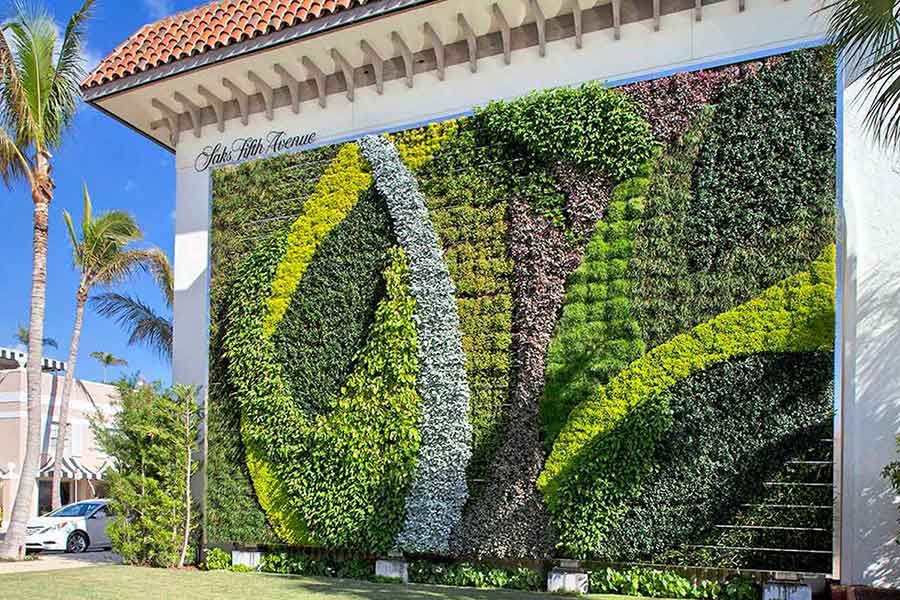
Living walls are usually a better choice for outdoor spaces or indoor areas where there is ample light. They are a great option for well-lit rooms, offices, cafes, restaurants, or for the front yard or backyard of your home. You can also earn tax credits and WELL credits for installing living walls in your office as they reduce your carbon footprint and improve employee wellbeing. Thus, they are an excellent option for plant-lovers and sustainability warriors.
What Are Preserved Moss Walls?
Preserved moss walls are green walls constructed using stabilized dead moss. These are not living plants but preserved moss plants that retain their natural greenery and texture due to the preservation process. Therefore, unlike living walls, preserved moss walls do not require water or sunlight. They are low-maintenance green walls that only need the occasional dusting. Plus, moss wall panels can be molded into various shapes and forms if you are looking for creative green décor ideas.

Preserved moss walls are more suitable for indoor spaces, especially if the area is dimly lit and does not receive much sunlight. Because they require minimal upkeep, they are a great choice for busy offices, restaurants, schools, and also for home interiors.
The Pros and Cons Of Living Walls
Pros for Living Walls
- Improve air quality by increasing oxygen levels and removing dust particles through their metabolic processes.
- Keep the area cooler in summers due to evapotranspiration and warmer in winters due to insulation, thereby reducing energy costs and decreasing your carbon footprint.
- Have noise-canceling properties and improve the acoustics of the room.
- In the United States, the government offers tax credits to businesses that install living walls, due to their contribution to the environment and employee wellness.
- Can be installed next to water bodies as they are not prone to water damage.
- They are suitable for outdoor spaces as they are more resilient against environmental damage and strong air currents.
- Are self-repairing and can recover from minor damage through regrowth.
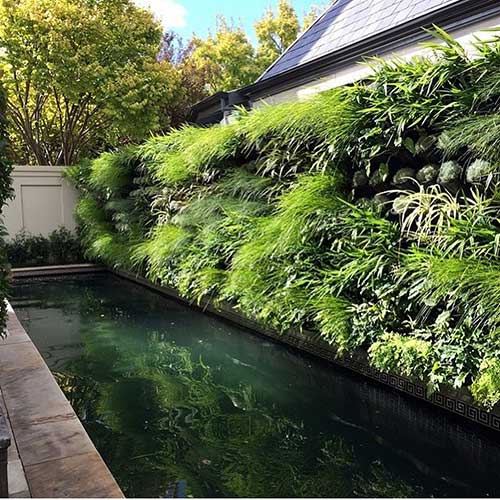
Cons for Living Walls
- Living walls demand regular upkeep and watering, and a daily dose of sunlight.
- They may release pollen into the air, which can be an allergen for some people.
- Are usually more expensive than preserved moss walls.
- If you wish to install a living wall in a poorly lit room, you will need to add lighting fixtures to provide enough light to the plants. This means additional cost and maintenance efforts.
Now that you know their pros and cons, here are some living wall ideas for design inspiration
If I see it in nature, I know it will work in a home
-Miles Redd, Interior Designer
The Pros and Cons Of Preserved Moss Walls
Pros for Moss Walls
- Require minimal upkeep and do not need water or sunlight for survival.
- Do not release pollen into the air and are more suitable for crowded places where people may have allergies, such as offices or restaurants.
- More affordable than living walls with a similar design.
- Can be installed in all indoor spaces, including dimly lit rooms.
- Have noise-canceling properties and improve the acoustics of the room.
- Offer more variety in terms of color, as dyes can be added during the preservation process.
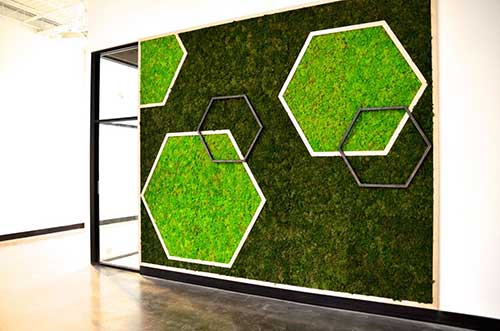
Cons for Moss Walls
- Should not be installed close to a radiator as they are inflammable. Also, they should not be installed directly in front of an AC as the convection current can dry them out.
- Cannot be placed near water bodies or fountains as they can get damaged by water contact.
- Once damaged, preserved moss cannot repair itself or regrow, as it is not a living plant.
If the pros outweigh the cons for you, check out these stunning preserved moss wall decor ideas that you can borrow for your space.
Living Walls vs. Preserved Moss Walls
To summarize the pros and cons of living walls and preserved walls, here is a table citing the key differences between the two.
| Living Walls | Preserved Moss Walls |
|---|---|
| Constructed using live plants. | Constructed using preserved dead mosses. |
| Require watering, upkeep, and ample light. | Low maintenance walls that do not require water or light. |
| More suitable for outdoor spaces or well-lit indoor areas. They are more resilient against wind currents and environmental damage. | More suitable for indoor spaces, including dimly-lit rooms. They survive the longest in rooms with humidity less than 70%, away from direct wind currents. |
| Save energy by cooling the space in summers and warming it in winters due to evapotranspiration and insulation respectively. | Do not have cooling properties but they may reduce humidity by absorbing environmental moisture. |
| Improve air quality by reducing dust and increasing oxygen levels through their metabolic processes. | Do not improve air quality. |
| May release pollen which is an allergen for some people. | Do not release pollen and are suitable for those with allergies. |
| Can self-repair or regrow after breakage. | Cannot self-repair after breakage or damage. |
| Can survive for up to 25 years with proper upkeep, depending on the plants used. | Can survive for 5 to 7 years. |
| Are suitable for installation near water bodies or fountains. | Can get damaged upon contact with water. |
| Not readily inflammable. | Are inflammable and should not be installed close to a radiator. |
| Usually more expensive than preserved moss walls. | More affordable for a similar design as compared to a living wall. |
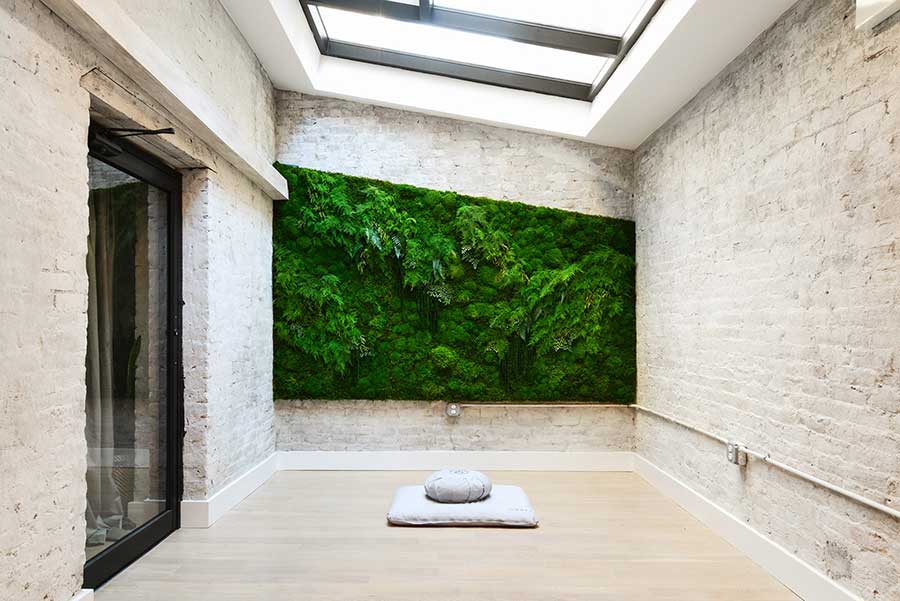
The Similarities Between Living Walls and Preserved Moss Walls
- Both living walls and preserved moss walls add a soothing element of greenery to the space that has a calming effect on the mind.
- They both offer noise-canceling benefits and improve the acoustics of the room.
- Both living walls and preserved moss walls pair well with other materials and textures, offering a seamless aesthetic to the space.
How To Choose Between Living Walls And Preserved Moss Walls
As you can see, both living walls and preserved moss walls come with their own pros and cons. Hence, to choose between the two, you need to understand which one fits your requirements better.

Choose A Living Wall If –
Image Source: gardeningknowhow.com
- The primary reason behind installing the green wall is to improve the air quality and temperature of the space.
- You are planning to install the green wall in an outdoor area or a well-lit indoor space. If the room is not well-lit, you will need to bear the additional expense of installing lighting fixtures.
- You enjoy gardening and do not mind the upkeep that a living wall demands, such as pruning and watering.
- The occupants of the space are not allergic to pollen. This may be difficult to ensure in places with a heavy footfall, like offices and restaurants.
- You plan to place the wall in the proximity of a water body; in high humidity or windy areas.
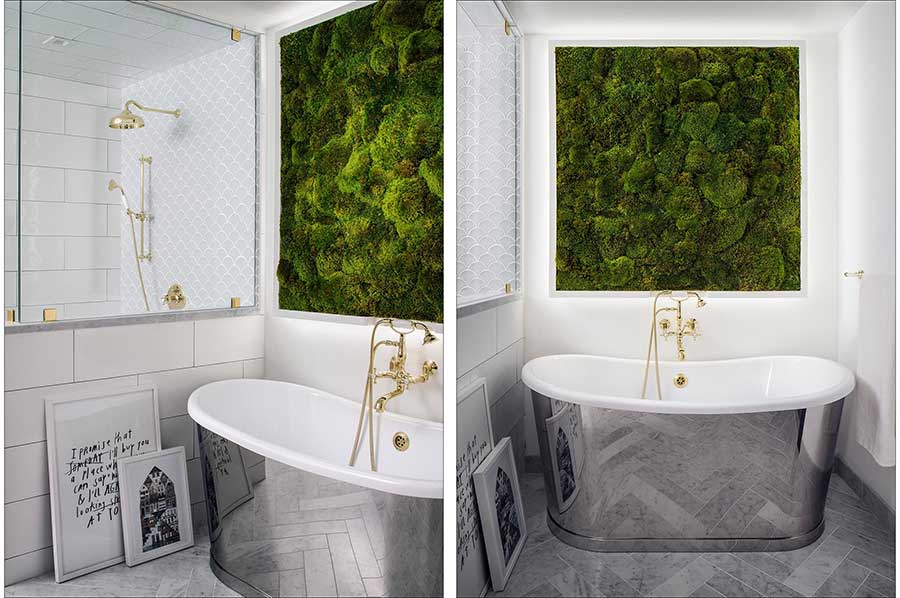
Choose A Preserved Moss Wall If –
Image Source: thespruce.com
- The primary reason behind installing the wall is to improve the aesthetics of the space.
- You want to add greenery to the décor and are not necessarily looking to improve the air quality or temperature of the room.
- You want to install the moss wall in a dimly lit indoor space that doesn’t get much sunlight.
- You want a low-maintenance fixture that does not demand daily upkeep.
- The occupants or visitors might be allergic to pollen, and you want a hypoallergenic fixture.
- You are looking to add some green elements to constrained or covered designs eg. behind glass panels, in company logos, etc.
- You are planning to install the indoor moss wall where there is a low risk of fire, water, or wind damage.
We hope that this in-depth comparison between living walls and preserved moss walls helps you choose the best option for your space. While they both have unique characteristics, at least one of them can surely help you go green with your interiors!
For any further assistance, our experts at Eco Brooklyn will be happy to help you with the best green wall installations in New York City.

